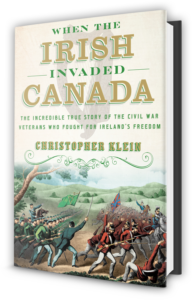New Fenian Raids Book
The Fenian Raids were a seminal moment in Canadian history, but a mere footnote in the United States. I’m hoping my new book on the Fenian Raids, When the Irish Invaded Canada, will make more people aware of the outlandish story of a band of Irish-American Civil War veterans who undertook one of the most improbable missions in military history—to kidnap the British colony of Canada and ransom it for Ireland’s independence.

When I first read about this bizarre coda to the Civil War, I probably wasn’t alone in wondering how many pints of Guinness were involved in concocting a plot to invade America’s northern neighbor. Part of that can be chalked up to viewing the past through the lens of the present day when the United States and Canada share the longest peaceful international border in the world.
The more research I conducted, however, the more I learned that the idea of attacking Canada in the 1800s wasn’t some whiskey-fueled delusion of grandeur, but as much of a time-honored American tradition as fireworks on the Fourth of July. In addition, after reclaiming the South, many Yankees had cast their eyes north in search of the next territory that would allow the United States to continue to fulfill its Manifest Destiny. Plus, Anglo-American relations were at their lowest ebb since the Redcoats torched the White House a half-century earlier because of the tacit British support given to the Confederacy during the Civil War. The United States sought reparations for the damage done by Confederate warships built in British ports and was more than willing to twist the lion’s tail in retaliation for the safe haven given to Confederate spies and raiders in Canada.
In the Fenian Brotherhood, a semi-secret band of Irish-American revolutionaries, the United States had the perfect vessel in which it could outsource their revenge. President Andrew Johnson and Secretary of State William Seward even signaled their intent not to interfere with the invasion plans, and the government sold large caches of weaponry to the private army.
The willingness of thousands of Irish immigrants to take such desperate measures speaks to the desperate times they faced. Even fifteen years after the Great Hunger that killed one million Irishmen and forced upwards of two million others to flee their homeland, the trauma remained raw. For seven hundred years, the British had taken away Ireland’s religion, culture, and language, and when the Great Hunger struck, they even took away its food and exported it to other realms of the British Empire. The Irish who washed ashore in the United States had become radicalized, and among the nearly two hundred thousand who took up arms for both the Union and Confederacy were many who saw the bloody battlefields of the Civil War as training grounds for the real fight they wanted to wage—a war to free Ireland.
How could you make such blatant errors simplistic errors? In your author’ note you state that prior to July 1 1867 present day Canada was referred to as British North America.
On page 63 of your book ‘How the Irish invaded Canada’ 2 pages after you state the date of March 17, 1866, you proceed to say;
‘ Killian also believed that they could expect help from those who opposed a growing movement to unite the provinces of Ontario, Quebec, Prince Edward Island, Newfoundland, New Brunswick and Nova Scotia in a semi-autonomous confederation’ and …..
Canada was not a country until July 1867.
The name of the government act that created Canada was called the British North America Act; the colonies/ territories were not called British North America.
The Act as stated on the British Parliament website, united the three separate territories of Canada, Nova Scotia and New Brunswick into a single dominion called Canada. The Act also divided the province/territory of Canada into Quebec and Ontario.
Newfoundland did not join Canada until 1949.
Prince Edward Island did not join Canada until 1873.
There were no provinces of Ontario, Quebec, Nova Scotia or New Brunswick until after Confederation.
Please if you are going to continue to write historical books, get the details correct.